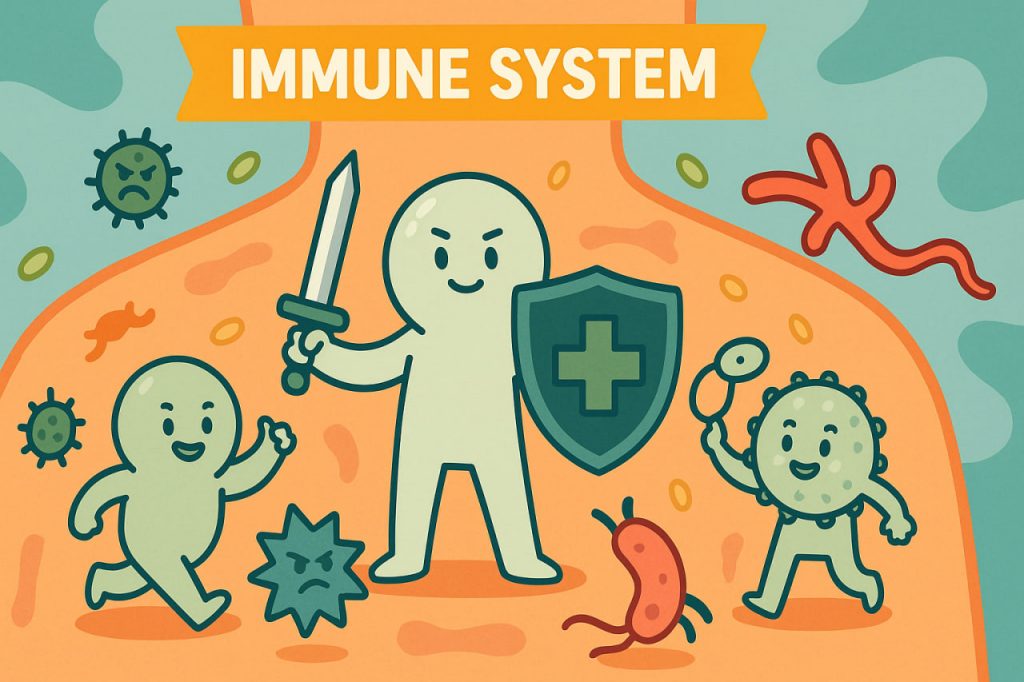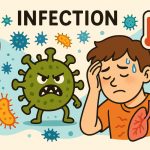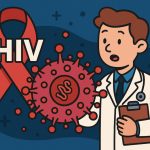The immune system is the body’s natural defense network that protects against harmful pathogens such as bacteria, viruses, fungi, and parasites. It is not a single organ but a complex system made up of specialized cells, tissues, and molecules. Its role is to detect foreign invaders, neutralize them, and remember them to ensure faster responses in the future. Without this system, humans would be vulnerable to constant infections. The immune system works continuously, maintaining balance between defense and tolerance to avoid attacking the body itself.
The Innate Immune Response
The innate immune system is the body’s first line of defense. It includes physical barriers such as skin, mucous membranes, and stomach acid, which prevent pathogens from entering. When microbes breach these barriers, cells like macrophages and neutrophils quickly attack them. This response is immediate but non-specific, meaning it reacts to general patterns found in many microbes. Inflammation, fever, and swelling are common signs of this process at work. The innate system buys time for the more specialized defense mechanisms to activate.
The Adaptive Immune Response
The adaptive immune system provides highly specific protection. It involves lymphocytes such as B cells and T cells. B cells produce antibodies, proteins that recognize and neutralize specific pathogens. T cells either kill infected cells or help regulate the immune response. A key feature of the adaptive system is memory: once it encounters a pathogen, it “remembers” it, leading to faster and stronger responses in future infections. Vaccines use this principle to prepare the immune system without causing illness.
Communication Between Cells
Immune cells communicate using chemical signals called cytokines. These molecules act as messengers, coordinating the attack and alerting other parts of the body. For example, cytokines can trigger inflammation, call immune cells to the site of infection, or signal when the danger is gone. This communication ensures that the immune response is targeted, efficient, and does not last longer than necessary. If cytokine signaling is disrupted, it can lead to chronic inflammation or autoimmunity.
Balance and Regulation
A healthy immune system must maintain balance. Overactivity may lead to autoimmune diseases, where the body attacks its own tissues, while underactivity results in immunodeficiency, leaving a person vulnerable to infections. The system uses regulatory cells and feedback mechanisms to control intensity and duration of responses. This regulation is essential to prevent excessive damage to healthy tissues during defense against pathogens. Maintaining overall health through nutrition, sleep, and stress management helps keep this balance stable.
Modern Challenges to the Immune System
In today’s world, the immune system faces new challenges. Pollution, poor diets, chronic stress, and the rise of antibiotic-resistant bacteria can weaken its effectiveness. Emerging diseases and global pandemics highlight the importance of understanding how immunity works. Scientific progress has brought immunotherapy, vaccines, and advanced diagnostics to strengthen and guide immune responses. However, self-medication is not advisable, and consultation with medical specialists is necessary when immune problems are suspected.
Conclusion
The human immune system is a sophisticated network that keeps the body safe from countless threats. It combines immediate defense with long-term memory, ensuring survival and resilience. Its balance is delicate, requiring both strong responses against pathogens and tolerance toward the body’s own cells. By understanding its functions, people can appreciate how vital it is to daily health. Ongoing research continues to reveal new ways to support and enhance immunity.
Glossary
- Immune system – the body’s defense network against disease-causing organisms.
- Pathogens – harmful microorganisms such as bacteria, viruses, fungi, and parasites.
- Innate immune system – the body’s first line of defense, providing quick, non-specific protection.
- Adaptive immune system – the specialized response involving B cells, T cells, and antibodies.
- Antibodies – proteins that recognize and neutralize specific pathogens.
- Cytokines – chemical messengers used by immune cells for communication.
- Autoimmune disease – a condition where the immune system mistakenly attacks the body’s own tissues.
- Immunodeficiency – weakened immunity that increases vulnerability to infections.


